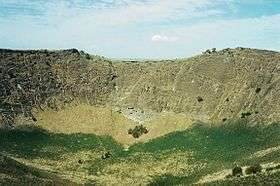Mount Schank
| Mount Shank | |
|---|---|
 View inside the cone from the rim | |
| Highest point | |
| Coordinates | 37°56′23″S 140°44′15″E / 37.93985°S 140.73761°ECoordinates: 37°56′23″S 140°44′15″E / 37.93985°S 140.73761°E |
| Geography | |
 Mount Shank | |
Mount Schank is a dormant maar volcano in the south-east of South Australia, near Mount Gambier. It was sighted by James Grant on 3 December 1800 and named after Admiral John Schank, designer of Grant's ship, the HMS Lady Nelson.[1][2]
Mount Schank is part of the Newer Volcanics Province,[3] which is the youngest volcanic field in Australia. Mount Schank erupted in the Holocene, 5,000 years ago, about the same time as Mount Gambier.[4][5] It is a very basic ash cone perhaps a hundred metres high, and the base of the crater does not extend below the water table, so there is no crater lake as with those at Mount Gambier. There are two small subsidiary craters adjacent to the main cone and some lava flows resulting from the eruption. The northern crater is circular, 300 m (980 ft) in diameter and 100 m (330 ft) deep, the older southern crater is 200 m (660 ft) in diameter and partially overlapped by the larger crater.[5]
The local Aboriginal Bunganditj people witnessed Mount Schank's eruptions over time. Their creation story about the local volcanic landscape was recorded by a local woman, Cristina Smith, in 1880. It tells the tale of Craitbul, a giant, who was looking for a place to live with his wife and two sons. They camped at Mount Muirhead and Mount Schank, but were scared away from both these camps by a moaning bird spirit. They fled to Mount Gambier, leaving their camp ovens (the volcanoes) burning. After some time, water came and filled their ovens, putting them out and driving the spirit away. They continued to live in a cave on the side of Mount Gambier.[6][7]

The site is accessible from the Riddoch Highway about 20 km (12 mi) south of Mount Gambier; there is a small carpark and picnic table, and steps have been placed to facilitate the short but very steep walk to the rim of the crater. It is a fairly simple walk to traverse the rim, though the exposed situation can be treacherous in gusty weather.
Spelling
The usual spelling of the location was "Schanck" until around 1916, when the current spelling was adopted. This may have been prompted by the then vogue for Anglicising German place-names, but the ancient Schank family, of whom the Admiral was a member, had that spelling for much of its history.[8]
See also
References
- ↑ Grant, James (1803). The narrative of a voyage of discovery, performed in His Majesty's vessel the Lady Nelson, of sixty tons burthen: with sliding keels, in the years 1800, 1801, and 1802, to New South Wales. Printed by C. Roworth for T. Egerton. p. 68. ISBN 978-0-7243-0036-5. Retrieved 25 January 2012.
- ↑ Lee, Ida (1915). The Logbooks of the Lady Nelson, with the journal of her first commander Lieutenant James Grant. London: Grafton. OL 6580132M.
- ↑ Price, RC., et al (2003) Cainozoic igneous activity. pp. 361-375 in Birch, WD., (editor) Geology of Victoria, Geological Society of Australia, Special Publication 23.
- ↑ Grimes, Ken (2013). "The Ages of Our Volcanoes" (PDF). Retrieved 2014-08-05.
- 1 2 Sheard, M.J. (1995) Quaternary volcanic activity and volcanic hazards. pp.265-268 in Drexel, JF., and Preiss, WV., The Geology of South Australia, Geological Survey of South Australia, Bulletin 54.
- ↑ Information board at base of Mount Schank, created by Primary Industries and Resources, Government of South Australia.
- ↑ "Mount Gambier – History". Travel in Mount Gambier. Retrieved 27 July 2011.
- ↑ "Spelling Of The Name Mount Schank.". The Border Watch. Mount Gambier, SA: National Library of Australia. 25 February 1947. p. 3. Retrieved 8 November 2012.